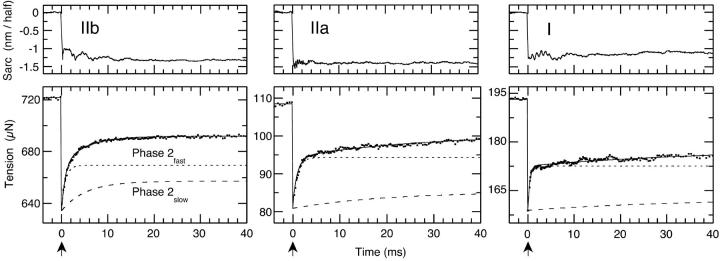FIGURE 1.
L-jump tension transients typical of fast, medium speed, and slow-fiber types. The Rabbit type IIb (fast) and mouse type IIa (medium speed) and I (slow fibers) fibers were subjected to small −1.5 nm/half-sarcomere step releases in ∼180 μs at a temperature of 6°C. Ten tension and sarcomere length transients were recorded and averaged. Contributions of the Huxley-Simmons phases 1, 2fast, 2slow, and 4 to the tension transient were determined by nonlinear least squares analysis and the resultant fit to these data drawn as a solid line through each data set. The simulated time-course of phase 2fast shows its rate to be independent of fiber type. The rate of phase 2slow, on the other hand, correlates with fiber type at low to moderate temperatures, slowing progressively from type IIb to IIa to I. Averaged tensions normalized to cross-sectional area presented as the mean ± SE were 117.4 ± 4.6 kN m−2, n = 9 at 6°C for type IIb fibers; 91.3 ± 7.6 kN m−2, n = 8 at 5°C for type IIa fibers and 97.6 ± 9.9 kN m−2, n = 10 at 5°C for type I fibers. The arrow indicates the point at which the step-release is applied.

